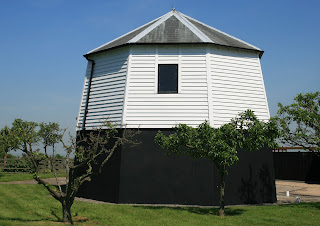Normally I tend to devise my own walks but on this occasion I followed a suggested 6.6 mile route from Kent County Council Explore Kent.
Many towns and villages in this part of North Kent including Higham claim links to the author Charles Dickens and trade on it to this day.
The walk starts and finishes at Higham station on the main line from London to the Medway towns. Dickens was an avid walker and covered on average 12 miles a day regardless of the weather.
From the station the route of the walk crosses over the railway bridge and then across open farmland towards the centre of Higham village.
Looking up the line towards Gravesend and London.
The distinctive buildings to the left of the picture are oast houses which were used for drying hops.
The church on the horizon is St John's church. It was consecrated in January 1862 and the Dickens family had a pew in the chancel. Dickens was a close friend of Joseph Hindle, the vicar of Higham.
Shortly after leaving the church you pass one of the village's remaining pubs, the Gardeners Arms.
On 14th March 1856 Dickens purchased Gads Hill Place and resided there until his death in 1870. A number of his famous books were written here including Great Expectations, A Tale of Two Cities and his final (unfinished work) The Mystery of Edwin Drood. The house was originally built in 1779.
Nowadays Gads Hill Place is used as a private school. At some point this year, when new school buildings are finished, it is due to become a Dickens museum and will be open to the public.
Opposite Gads Hill Place is another watering hole, the Sir John Falstaff where Dickens guests were sometimes accommodated.
The walk climbs up Telegraph Hill adjacent to the pub. At the top of the hill is a concrete obelisk shaped monument to Charles Larkin a local political reformer who died in 1833. Unfortunately despite being mentioned in the KCC guide the entry to the field where the monument is located was padlocked shut. A bit of a disappointment on an otherwise excellent walk.
The walk passes along Hermitage Road with good views across the farmland towards the river (Thames).
The base of a windmill originally built in the 1760's but partly demolished in 1921.
The horses in the neighbouring paddock were very pleased to see me and followed me for some way. I think they thought I had some sugar lumps about my person!
Poplar trees surrounded by cow parsley. Not a bad place to stop for a quick sandwich before continuing on to Higham's second and original parish church, St Marys.
Parts of the church date back to the 13th century but there is evidence of earlier Saxon and Norman churches at the site. The church is no longer in regular use but is maintained by a national charity called The Churches Conservation Trust. It is open daily to visitors.
On 17th July 1860, Dickens' daughter Katey was married at the church. Reverend Hindle conducted the ceremony. Katey's mother Catherine was not at the wedding. Dickens had separated from her in 1858 after starting a secret affair with actress Ellen Ternan.
Dickens with his daughters Katey and Mary.
The stained glass windows are very impressive especially when the sun shines through.
Medieval floor tiles near the altar.
The door to the church is adorned with crude carvings thought to be from the 14th century.
After leaving the church the walk heads back to the starting point at Higham station and passing two more pubs.
The Chequers above closed a few years ago and has now been converted into apartments.
The final pub of the walk is the appropriately named Railway Tavern. I would recommend this walk. It is mainly over easy ground with plenty of points of interest and good views over the countryside.
If you have enjoyed this post you may also like....


























Nothing would get me to walk that far, but travelling by bike might be a good alternative :)
ReplyDeleteNow ... onto the question of Dickens and his pubs. When I was examining Charles Dickens' links to Broadstairs, it occurred to me that he must have been a VERY popular drinker! At least three pubs in Broadstairs still claim him as a patron. You have found two or three more pubs in Higham that he frequented in his later life, including the very lovely Gardeners Arms and the Sir John Falstaff.
Thanks for the link
Hels
http://melbourneblogger.blogspot.com.au/2011/07/charles-dickens-years-in-broadstairs.html
Very interesting. I used to some walking and cycling in Kent when my friend lived in Canterbury.
ReplyDeleteMany of the buildings are very nice and I remember it was usually dry when I visited, unlike the weather I am used to in the West of Scotland.
One thing I never got used to was how early darkness fell in the summer months. However, I always liked Kent and remember it fondly.
Hels, Dickens certainly liked his pubs! (after all which true Englishman doesn't?) He used to frequent pubs to observe the characters and get inspiration for his writing.
ReplyDeleteJane - thanks for your comment. Our weather has been pretty abysmal here lately too if it makes you feel any better :-)
Glen
Hi Glen
ReplyDeleteI know all of those pubs!We did a walk a little while back,Gravesend to Higham then on the train back.One of the pubs is frequented by a couple of very famous people .I particularly like the stained glass "shadow"on the casement,never seen that before.
GP.